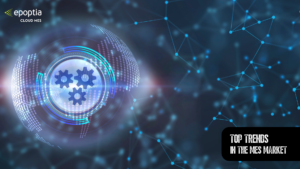Learn about Overall Equipment Effectiveness, a KPI measuring how effectively resources operate in a manufacturing business
Ιn the world of manufacturing, optimizing operational efficiency is a key goal for businesses seeking to maximize productivity and profitability. One important metric that plays a crucial role in measuring and improving efficiency is Overall Equipment Effectiveness (OEE). OEE provides insights into how effectively equipment is being utilized, helping manufacturers identify areas for improvement and drive continuous operational excellence. In this article, we will delve into the concept of OEE, explore its calculation formula, and discuss its significance in manufacturing. Furthermore, we will highlight how Epoptia MES, a comprehensive manufacturing execution system, can enhance OEE and empower businesses to achieve their production goals.
What is Overall Equipment Effectiveness (OEE)?
OEE is a comprehensive metric that measures the performance of manufacturing equipment by evaluating three things:
1. Availability
2. Performance
3. Quality
More specifically, it provides a holistic view of how effectively a resource or process operates. It does that by taking into account both planned and unplanned downtime, production speed and product quality. OEE is commonly used to identify areas of inefficiency, track improvements over time and optimize production processes.
How to Calculate Overall Equipment Effectiveness
As mentioned above, Overall Equipment Effectiveness consists of three underlying measures: Availability, Performance and Quality. The formula to calculate OEE is as follows:
OEE = Availability x Performance x Quality
Now, let’s break down and analyze each component of the formula.
Availability: Availability measures the actual production time of equipment compared to the planned production time. It considers factors such as equipment breakdowns, changeovers and scheduled maintenance. The formula for availability is:
Availability = (Operating Time – Downtime) / Operating Time
For instance, let’s consider a production schedule that allocates 6.5 hours for a specific resource. However, due to an unexpected breakdown, the resource was non-operational for 1 hour. Additionally, there were two changeovers during the production run, each
taking 15 minutes. In this case, the real operating time would be 4.5 hours. The availability rate can be calculated as:
5 / 6.5 = 0.769 = 76.9%
This indicates that the resource was available for production 76.9% of the scheduled time.
Performance: Performance evaluates the speed and efficiency of the equipment by comparing the actual production rate to the ideal production rate. It considers factors such as equipment speed losses, minor stops and idling time. The formula for performance is:
Performance = (Ideal Cycle Time x Total Count) / Operating Time
Now, let’s consider another example where a resource had a real run time of 6.5 hours during an 8-hour shift. The ideal cycle time per unit is 2 minutes (0.0333 hours), and the resource processed a total of 400 units in that time. The performance rate can be calculated as follows:
Performance = (400 units x 0.0333 hours) / 6.5 hours
Performance ≈ 2.04 or 204%
In this case, the performance rate is 204%, indicating that the resource operated at a faster pace compared to the ideal cycle time, resulting in higher productivity.
Quality: Quality measures the percentage of products that meet the required quality standards. It considers factors such as defects, rework and scrap. Rework is an important aspect of quality measurement within OEE. It refers to correcting products that don’t meet quality standards and it impacts overall quality performance and production costs. Also, analyzing rework helps identify root causes and implement improvements. The formula for quality is:
Quality = (Good Count / Total Count) * [(Net Runtime-Rework time) / Net Runtime]
Continuing with the example of the resource operating for 6.5 hours and processing 400 units (with Good Count: 380 units, 20 defects and 1 hour Rework Time), let’s calculate the quality rate using the above formula:
Quality = (380 units / 400 units) * [(6.5 hours – 1 hour) / 6.5 hours] = (0.95) * (5.5 hours / 6.5 hours) = 0.95 * 0.846
Quality ≈ 0.805 or 80.5%
Therefore, the quality rate for this example is approximately 80.5%. This indicates that 80.5% of the units processed were without defects, considering the adjustments for net runtime and rework time.
By multiplying the availability, performance and quality percentages together, you can obtain the OEE score, which represents the overall effectiveness of the equipment or process.
With numbers from the previous examples, we get an OEE of:
OEE = 76.9% x 204% x 80.5%
OEE ≈ 1.257, or 125.7%
Significance of Overall Equipment Efficiency in Manufacturing
Calculating OEE provides manufacturers with valuable insights and benefits, including:
1. Identifying bottlenecks and areas for improvement: OEE analysis helps pinpoint specific areas where equipment performance, availability, or quality can be enhanced, allowing manufacturers to prioritize improvements and optimize their production processes.
2. Enabling data-driven decision-making: OEE provides real-time and historical data on equipment performance, enabling manufacturers to make informed decisions about resource allocation, maintenance schedules, and process optimizations.
3. Driving continuous improvement: OEE serves as a benchmark for measuring improvement efforts over time. By monitoring OEE regularly and implementing targeted improvement initiatives, manufacturers can achieve incremental progress and drive continuous improvement.
4. Enhancing productivity and profitability: By increasing equipment efficiency, reducing downtime and improving product quality, OEE optimization directly impacts productivity and profitability. It allows manufacturers to maximize their output and reduce waste, ultimately boosting the bottom line.
Epoptia, offers Real-time OEE monitoring, allowing manufacturers to identify performance issues promptly and take proactive measures. Moreover, its historical data analysis enables manufacturers to analyze trends, identify patterns and make data-driven decisions for process improvements. Additionally, automated data collection eliminates manual entry errors and ensures accurate and reliable OEE calculations. What is more, Epoptia MES provides tools to track, analyze and manage rework instances. Reducing rework improves product quality, reduces costs and enhances operational efficiency. Ultimately, its proactive alerts and notifications help address OEE deviations quickly, minimizing downtime and maximizing efficiency.
Don’t hesitate to reach out and request a presentation to explore how Epoptia MES can empower your manufacturing operations and drive continuous improvement and operational excellence.
For more information, check https://bit.ly/3vYnb4f.




















